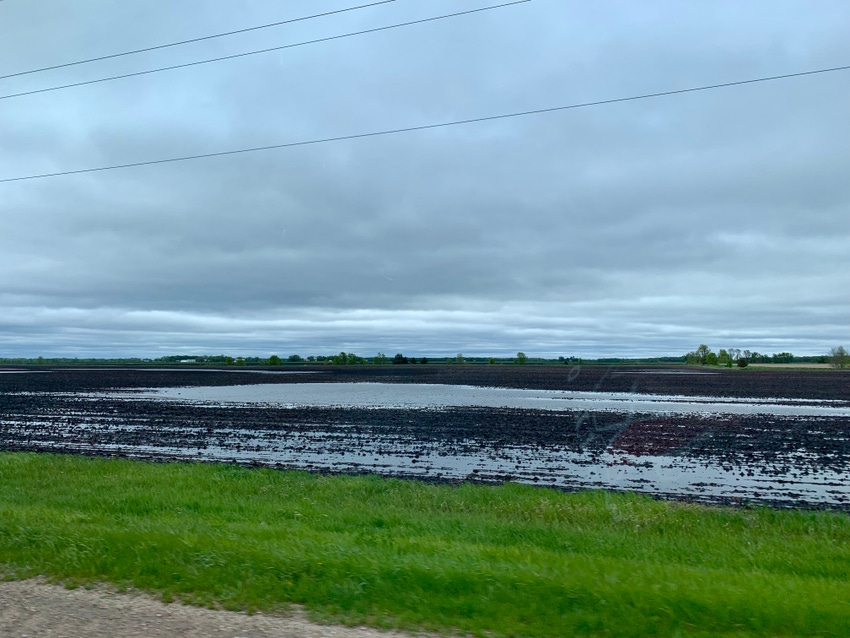
Farm operators in many portions of the Midwest, including parts of southern Minnesota and northern Iowa, are dealing with very wet field conditions and delayed crop planting. Unless conditions improve soon, some producers could be forced to consider not planting a portion of their crops in 2019. As we approach June 1, producers in the affected areas will be evaluating their crop insurance coverage for late planting or prevented planting options, as compared to the yield and profit potential for late planted corn and soybeans.
The Final Planting Date for corn is May 31 in the southern two-thirds of Minnesota, all of Iowa and all but the northern few counties in Wisconsin, as well as a few counties in both southeast South Dakota and North Dakota, in order to receive full crop insurance coverage for 2019. The Late Planting Period for corn is 25 days, which would be from June 1-25, with a reduction in the insurance coverage level of 1 percent for each day that corn planting is delayed past May 31. In northern Minnesota and extreme northern Wisconsin, as well as many counties in North and South Dakota, the final date for corn planting with full insurance coverage is May 25, with the late planting date extending to June 19. Following the late planting period, the maximum crop insurance coverage is 55 percent of the insurance guarantee, which is the same as the insurance compensation for Prevented Plant crop acres.
For soybeans, the Final Planting Date is June 10 in Minnesota, eastern North and South Dakota and the northern two-thirds of Wisconsin, with the late planting period extending 25 days until July 5. The final soybean planting date is June 15 in Iowa and the southern one-third of Wisconsin, with the late planting period lasting until July 10. As with corn, there is reduction of 1 percent per day in the maximum insurance coverage during the late planting period, with 60 percent maximum insurance coverage after that period.
Once the crop insurance Final Planting Date for corn or soybeans has been reached for corn or soybeans, farm operators can opt to take the prevented planting insurance coverage, if they have that coverage option, rather than planting the crop. A large majority of producers in the Upper Midwest carry Revenue Protection (RP) crop insurance with prevented planting coverage on their corn and soybeans. If they choose the prevented planting coverage, they will receive 55 percent of their original crop insurance guarantee for corn and 60 percent for soybeans on a specific farm unit.
Crop producers will have different yield potential, crop expenses, land costs, etc. on various farm units, as well as differences in their level of crop insurance coverage and revue guarantees on various farms. All of these factors become important when evaluating prevented planting crop insurance decisions. It is also important to note that the guaranteed payments for prevented planting with corn and soybeans are considerably less in 2018, as compared to several years ago. The decision that your neighbor makes regarding prevented planting may not necessarily be the best decision on your farm, depending on the situation and the factors involved.
Producers should contact their crop insurance agent for more details on final planting dates and prevented planting options with various crop insurance policies, before making a final decision on prevented planting. In addition, the prevented plated acres need to be reported to their crop insurance agent. The USDA Risk Management Agency (RMA) has some very good crop insurance fact sheets and planting date maps available on their website.
Assuming that producers have an eligible Revenue Protection (RP) or Yield Protection (YP) crop insurance policy, they would have the following options with regards to delayed or prevented planting later than the established final planting dates (listed earlier):
Plant the insured crop during the late planting period, which is typically 25 days following the final planting date for a given crop. (For example, planting corn after the May 31 final planting date.) The maximum crop insurance coverage is reduced by one percent per day for each day after the final planting date that the corn is planted. (Corn planted on June 10 would have 90% of original insurance guarantee.)
Plant another crop (second crop) after the final planting date. For example, soybeans could be planted on intended corn acres after May 31, in that case, there would be no prevented planting coverage payment eligibility for the corn acres, and the soybeans would be treated as insurable soybean acres.
File a Prevented Planting crop insurance claim on the qualifying original unplanted acres after the Final Planting Date. (May 31 for corn and June 10 for soybeans.) The producer will receive a prevented planting payment per eligible acre equal to the original revenue guarantee times 55 percent (.55) for corn and 60 percent (.60) for soybeans. The original revenue guarantee is the APH yield times the crop insurance Spring base price ($4.00 per bushel for corn and $9.54 per bushel for soybeans) times the level of RP coverage level. Following are examples with 80% RP coverage on corn and 85% RP coverage on soybeans: Corn:190 Bu./A x $4.00/Bu. x .80 = $608.00 x .55 = $334.40 prev. planting payment; soybean: 55 Bu./A x $9.54Bu. x .85 = $474.98 x .60 = $267.60 prev. planting payment.
To qualify for Prevented Planting insurance coverage and payments, affected areas must be the lower of 20 acres, or 20 percent of the total eligible insured acreage in a farm unit. The maximum acreage eligible for prevented planting coverage is limited to the number of acres in the insurable farm unit. Furthermore, the maximum eligible acres for a given crop is the highest number of acres planted to that crop on that insurable farm unit in the past four years, regardless of the planned crop acreage for 2019.
I have prepared an information sheet, Late and Prevented Planting Options for 2019, which contains details on prevented planting requirements and considerations, as well as tables comparing the potential results for options of late planting or prevented planting with normal production for corn and soybeans. To receive a copy of the prevented planting information sheet, please e-mail [email protected].
Iowa State University and the University of Illionois FarmDoc. websites have both developed very good spreadsheets to evaluate late and prevented planting crop decisions.
https://www.extension.iastate.edu/agdm/cdcostsreturns.html (Iowa State University)
Every producer’s situation is different regarding late and prevented planting options, as a result, the best option will vary considerably from farm-to-farm, based on differences in yield potential and insurance coverage. The choice that a producer makes could result in a difference of thousands of dollars in the potential insurance coverage that is available. This is why it is extremely critical for producers to consult with their crop insurance agent before finalizing late and prevented planting crop decisions.
About the Author(s)
You May Also Like






